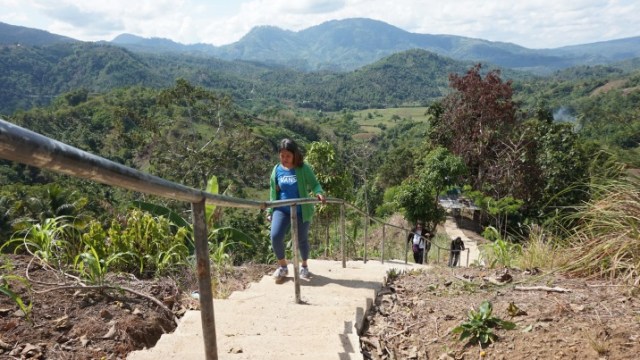Imagine to have walked around 3 kilometers on a muddy ground from your home to the nearest hi-way doing your daily routine of either going to school, doing errands, attending to business or any form of livelihood, and many more. Sounds ordinary? But what if these 3 kilometers is an uphill- 3 hour climb? And a roadless one. These challenges are known to a lot of poor communities in the region that Kalahi-CIDSS serves.
But this is not the only case for a barangay in Kumalarang. Limamawan is an uphill barangay which has around 96 Subanen households. Located around 3 kilometers from the hi-way, at around 1,350 feet above sea level, the trail to and from the barangay entails a lot of adventure to the community and all the more to the people who visits the area for the provision of basic social services.
For one, they do not have road. The community created a path from which they can easily climb up and in going down. The terrain is too stiff and the path couldn’t sustain due to the excessive rainfall in the area that it washes away and turns into mud-like form. Once this turned muddy, it becomes too dangerous to pass, and it tends to become too slippery that if not careful, one could slip into the cliff.

“Mahirap ang buhay, lalo kapag magbababa ng benta, mga saging, kamote, utan. Lisod ang agianan , wala’y kuryente, solar lang source”, expressed by Marilou P. Tabiliran, BSPMC Chairperson of the said sub-project.
(Life is difficult, especially when we need to bring our produce downtown like banana, crops and vegetables. The road is hard to pass, no source of electricity, only by solar).
It is also equally dangerous on dry days, when one could be caught up in the middle of the scorching hit carrying heavy baggage, as the trail will tire you and dry you up.
But all these are their everyday grind. Bringing with them sacks of farm produce, most of the time it get wasted due to difficulty and inconvenience in transporting these downtown.
Most of them earn their living through farming, as the environment is suitable for growing crops, corn, and vegetables. Despite the meager income, through these they were able to feed their families and even send their kids to school.
However, they believe that they can do better with their harvest if the path is in good condition considering that they can’t make use of motorcycle or any form of vehicle in climbing.


During Cycle 3 Implementation of Kalahi-CIDSS, their proposed sub-project “Concreting of Uphill Stairway” was prioritized. But the implementation was confronted with a lot of challenges particularly in the hauling of materials, the labor group, and the weather and terrain condition. All these had factored in the untimely completion of the sub-project. Just imagine the difficulty in bringing all these materials, sacks of cement, steelbar, metal roofing and wood at such height. But the community was so determined to finish the sub-project, to them it’s their most aspired project. So they tried to help in any possible way to get the job done with the help also of the Local Government.
By April 30, 2019, the Concreting of Uphill Stairway with 3 Interval Sheds was turned-over to the community. The sub-project which has a total cost of Php1,977,780.00 has a 1,950 concrete step with steel handgrip and interval sheds as resting station.
“Mas dali ang paglakaw , panahon sa ulan dili na danlug. Sa mga estudyante sayo na ang ilang pagnaog sa highschool. Sa mag-uma mapadali na ang pagagi kay dili na danlug sa panahon sa ulan”, shared by Marilou P. Tabiliran, BSPMC Chairperson of the said sub-project.
With the completion, the Limamawans is looking forward to a better returns of farm produce when transporting, safe passage for students, and easier access of basic social services come sunny or even rainy season.
Indeed for them, who have found shelter in the comfort of the mountain, climbing home is worth every step. Kalahi-CIDSS is a poverty reduction program that aims to improve the delivery of social services in poor communities. Local residents are empowered to engage in planning and implementation of community projects that would best address their needs.



You must be logged in to post a comment.